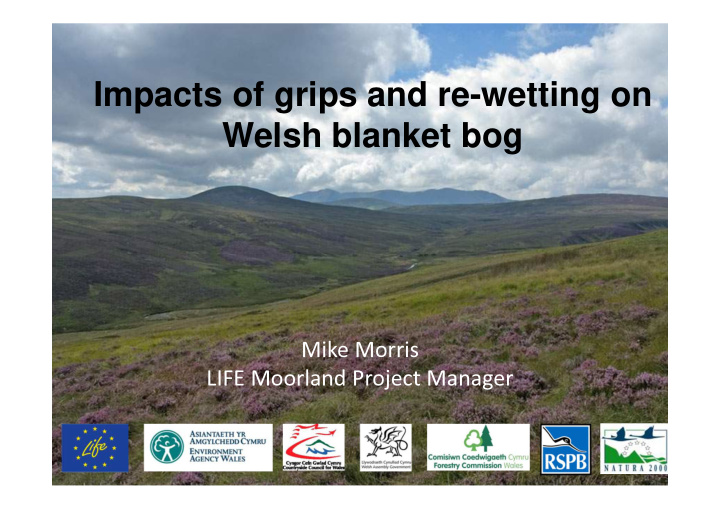



Impacts of grips and re-wetting on Welsh blanket bog Mike Morris LIFE Moorland Project Manager
The study site Lake Vyrnwy catchment: - 10,000 ha - approx. 4,800 ha blanket bog - upland areas were drained in 1950-70s - Special Area of Conservation (Habitats Directive) Lake Vyrnwy - blanket bog in ‘unfavourable’ condition due to drainage & historic overgrazing & burning - Lake is water supply to Liverpool -Upland areas are hill farmed by the Royal Society for the Protection of Birds (low levels, April-Oct only)
The project aims •Restore damaged blanket bog to ‘favourable’ condition –Blocking drainage ditches across a large upland catchment –Removal of self-seeding non-native species •Structure restoration to provide experimental conditions –4 sub-catchments, blocked sequentially 1 per winter –Longitudinal (before/after) data per sub-catchment –Experiment/Control data between sub-catchments •Research targeted to address stakeholder concerns & project priorities. –Recovery of vegetation? –Recovery of conditions for vegetation (higher, stable water tables)? –Effects on organic carbon release & discharge water colour? –Implications for flood risk management?
The study site Local farming concerns – Traditional farming methods – Ground will become too wet – Stock loss in wetter areas – Increase in parasites
Invertebrate surveys 25 20 Tipulid abundance 15 10 5 0 Open Blocked Value Std.Error DF t-value p-value (Intercept) -0.1545802 0.2345055 84 -0.659175 0.5116 blocked1 1.3077334 0.3209386 26 4.074715 0.0004 i.e. in simple blocked vs open comparison, blocked has significantly more tipulids
Vegetation field methods
LIFE Vegetation Monitoring 30 fixed transects with 10 1m 2 quadrats each • • Quadrats were 50:50 on grip/non-grip areas Within each quadrat the following was recorded: • Species composition, abundance, height and structure measures • Evidence of grazing/sheep presence • Depth of peat • Location, altitude, aspect • Area of heather mowing • Area of ditch blocking waste material
Summary • Vegetation – Grips have not, overall, been successful in drying areas to match surrounding habitats – At individual grip scales, there is evidence of a ‘drying zone’ (key blanket bog species lower abundance within 15m of grip) • Sheep – Sheep presence was strongly linked to drier areas – Sheep largely avoid areas of drained bog – Greater grazing pressure directly adjacent to grips.
Local farming concerns • Traditional farming methods – Upland draining – High stocking rates – Liming – Removal of cattle/ponies
Drain impacts Graminoid species height lower close to drain Weak decline in Sphagnum species nearer drains
Sheep presence Sheep presence associated with shorter vegetation and Graminoid abundance Lower C. vulgaris and other dwarf shrubs cover with sheep presence
Local farming concerns • Ground will become too wet – Stock loss – Reduction in grazing levels – Loss of income
Sheep presence Drained areas have 5-33cm deeper peat Sheep presence lower in drained areas
Local farming concerns • Stock loss in wetter areas – Stock becoming stuck – Stock loss in grips vs newly created wetter areas
30 sheep carcasses during restoration Survey: 6 months 7500m 898 individual pools 0 sheep in 2 years Dams installed on hefted routes. Pools profiled.
April 2007 May 2010
Local farming concerns • Increase in parasites – Tick ( Ixodes ricinus ) i. April & August surveying ii. Two catchments – Liver fluke ( Fasciola hepatica ) i. Random surveying of bog pools
Farming response 90 80 70 Number of responses Total 60 Positive 50 Negative 40 Unknow n 30 Visits 20 10 0 Berw yn SAC Migneint SAC
Impacts on farming • True impacts of drains • Stock loss • Parasites � Nine private landowner agreements � Extra 1000 ha blanket bog restoration
Acknowledgements Thanks to Lorraine Wilson, Matthew Carroll, Joe Holden, Alona Armstrong, Jared Wilson, Ian Johnstone, Fiona Walker, Jude Lane, ECUS Ltd EU LIFE-Nature Fund and project partners (RSPB, CCW, EAW, FCW) www.blanketbogswales.org
“If your ankles get wet, that’s a bog”, said Eeyore. “I see”, said Pooh. “Whereas”, continued Eeyore, “if you sink in up to your neck, that’s a swamp”. AA Milne
Recommend
More recommend